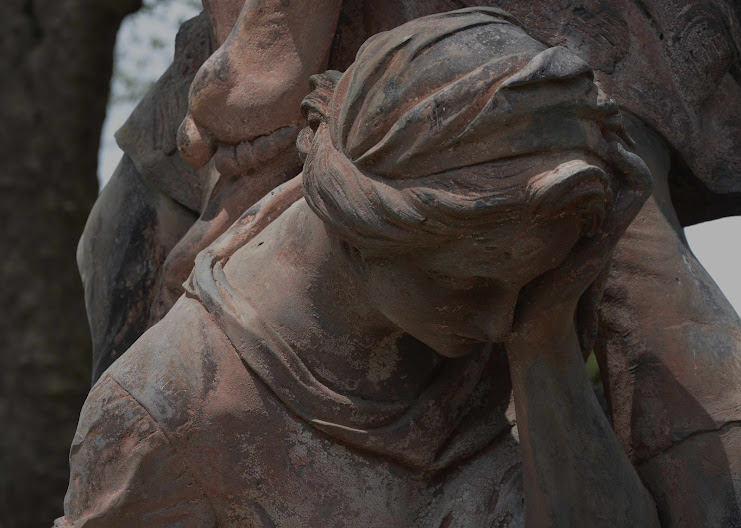................................
Aeneas and Anchises - the Lead Group at the Royal Palace of Queluz, Portugal.
Photographs taken by the Author.
For the restoration of this group and the Rape of the Sabines at Rupert Harris's Studio in East London see -
The remains of early paint schemes were found on the
sculpture's surface. Samples were taken for analysis, which revealed that the
sculpture had received at least six paint treatments up until the early 20th
century. These schemes were all of light grey/stone colours. The red colour so
visible now on one of the sculptures is the remains of a coat of red iron oxide
primer, applied prior to a 19th century application of stone-coloured paint.
Several parts of the sculpture were found to be missing, or damaged beyond repair. Moulds were taken from the group at Wrest Park, and the missing pieces were cast in lead and attached to the sculpture.
Damaged areas were then repaired by lead burning and a new stainless steel armature inserted to support the sculpture and the base area.
........................
Made during the artist's stay at the Académie de France in Rome from 1697, transported to France in 1715 to adorn the garden of the Château de Marly, the work now kept in the Louvre Museum.
From a wax sketch entrusted by Girardon to Lepautre in April 1696, during the latter's visit to Paris.
Wax model by Lepautre, completed at the French Academy in Rome, in November 1696.
Large plaster model completed July 1697. Terracotta completed December 1697.
Marble block issued September 17, 1697. Marble started October 1697.
Third clay model, December 1697. Return to France of the sculptor, February 1701. Sent from Rome in April 1715 and placed unfinished in the park of Marly in August 1715.
Completed with the help of Jacques Bousseau, in 1716. Placed in the Tuileries Garden, west of the circular basin in 1717.
It should be noted the Bousseau was closely connected with Louis Francois Roubiliac - when Joseph Highmore was in Paris in 1734.
Roubiliac provided a letter of introduction to Jaques
Bousseau for the English painter Joseph Highmore (1692 - 1780) who was visiting
Paris in 1734.
For Highmore in France see - https://www.journal18.org/issue2/an-englishman-in-paris-joseph-highmore-at-the-academie-royale/
.........................
The V and A Terracotta inscribed P. le Pautre, 1715.
Height: 25.6cm Width: 14cm (maximum) Depth: 10.5cm (maximum).
A terracotta model in reduction of the original marble work is now kept in the Victoria and Albert Museum in London. In the 18th century, Lepautre himself had kept a copy in his workshop and Lalive de Jully, the famous introducer of Louis XV's ambassadors, also had another.
Purchased by the John Webb Trust in 1939.
....................
In book two of Virgil's epic poem The Aeneid (29-19 BC), the
Trojan hero Aeneas escapes from the burning city of Troy and its Greek invaders
with his family. Here the artist shows them making their way through a
classical corridor. Aeneas carries his elderly father, Anchises, entrusted with
holding their household gods. Aeneas holds the hand of his son, Ascanius, and
his wife Creusa follows behind. Creusa's separation from the group alludes to
her fate: she will fall behind and not survive their flight.
Print made by: Agostino Carracci, After: Federico Barocci,
Published by: Donato Rasciotti, 1595.
https://www.britishmuseum.org/collection/object/P_V-8-186
for a preparatory drawing for the lost painting see
https://www.clevelandart.org/art/1960.26
...............................
Rondel at the Soane Museum.
Probably John Bacon.

























